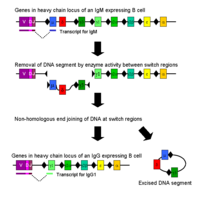
Photo from wikipedia
Immunoglobulin class switch recombination (CSR) plays an important role in humoral imm\une responses by changing the effector functions of antibodies. CSR occurs between highly repetitive switch (S) sequences located upstream… Click to show full abstract
Immunoglobulin class switch recombination (CSR) plays an important role in humoral imm\une responses by changing the effector functions of antibodies. CSR occurs between highly repetitive switch (S) sequences located upstream of immunoglobulin constant gene exons. Switch sequences differ in size, the nature of their repeats, and the density of the motifs targeted by the activation-induced cytidine deaminase (AID), the enzyme that initiates CSR. CSR involves double-strand breaks (DSBs) at the universal Sµ donor region and one of the acceptor S regions. The DSBs ends are fused by the classical non-homologous end-joining (C-NHEJ) and the alternative-NHEJ (A-NHEJ) pathways. Of the two pathways, the A-NHEJ displays a bias towards longer junctional micro-homologies (MHs). The Sµ region displays features that distinguish it from other S regions, but the molecular basis of Sµ specificity is ill-understood. We used a mouse line in which the downstream Sγ3 region was put under the control of the Eµ enhancer, which regulates Sµ, and analyzed its recombination activity by CSR-HTGTS. Here, we show that provision of Eµ enhancer to Sγ3 is sufficient to confer the recombinational features of Sµ to Sγ3, including efficient AID recruitment, enhanced internal deletions and robust donor function in CSR. Moreover, junctions involving Sγ3 display a bias for longer MH irrespective of sequence homology with switch acceptor sites. The data suggest that the propensity for increased MH usage is an intrinsic property of Sγ3 sequence, and that the tandem repeats of the donor site influence the choice of the A-NHEJ.
Journal Title: Frontiers in Immunology
Year Published: 2022
Link to full text (if available)
Share on Social Media: Sign Up to like & get
recommendations!